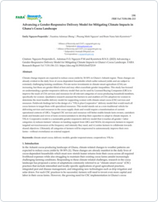Advancing a Gender-Responsive Delivery Model for Mitigating Climate Impacts in Ghana’s Cocoa Landscape
Abstract
This framework stresses the importance of understanding the multi- layered determinants that intersect with gender to shape men’s and women’s differentiated vulnerabilities to climate impacts on their labor and livelihoods and abilities to cope with such impacts through the adoption of CSC practices. [...] Under official and expected caretaking arrangements, caretakers provide 100% of the labor on cocoa farms and receive one-third of the income; meanwhile the farm owners receive two-thirds, with the agreement of re-investing one-third on inputs for the farm (Figure 4). [...] Targeted Services for Different Categories of Farmers To support cocoa farmers in adopting CSC practices, targeted services and resources are required to meet the specific requirements and contexts of all relevant gender and landholding categories of farmers, as seen in Table 2 below. [...] Details on the practical implementation of the model are dependent on the context of the cocoa-growing region—such as the strength of its existing VSLAs and cooperatives—as well as the objectives of the LBC. [...] The Phase- based approach to this model provides guidance on those specific targeted services and resources as well as tactical and strategic actions that provide the enabling environment that cocoa farmers—of all categories—need to improve the resilience of their cocoa farms and households when subject to adverse climate impacts.

